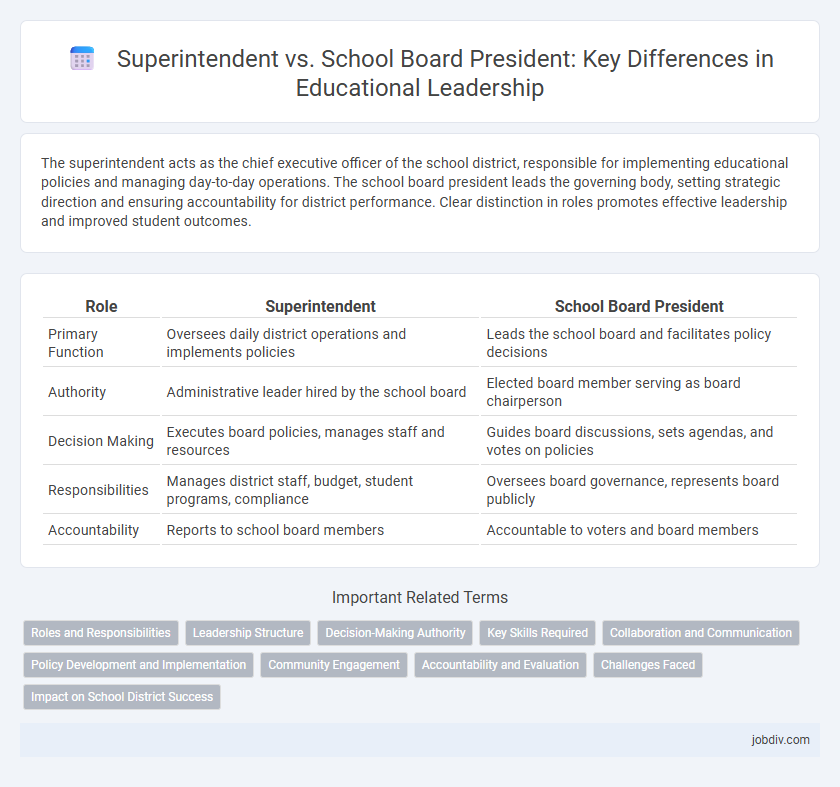The superintendent acts as the chief executive officer of the school district, responsible for implementing educational policies and managing day-to-day operations. The school board president leads the governing body, setting strategic direction and ensuring accountability for district performance. Clear distinction in roles promotes effective leadership and improved student outcomes.
Table of Comparison
| Role | Superintendent | School Board President |
|---|---|---|
| Primary Function | Oversees daily district operations and implements policies | Leads the school board and facilitates policy decisions |
| Authority | Administrative leader hired by the school board | Elected board member serving as board chairperson |
| Decision Making | Executes board policies, manages staff and resources | Guides board discussions, sets agendas, and votes on policies |
| Responsibilities | Manages district staff, budget, student programs, compliance | Oversees board governance, represents board publicly |
| Accountability | Reports to school board members | Accountable to voters and board members |
Roles and Responsibilities
The superintendent serves as the chief executive officer of the school district, overseeing daily operations, implementing policies, managing staff, and ensuring educational standards are met. The school board president leads the board by setting meeting agendas, facilitating discussions, and acting as a liaison between the board members and the superintendent. While the superintendent handles administrative execution, the school board president focuses on governance, policy-making, and community representation.
Leadership Structure
The superintendent serves as the chief executive officer of a school district, responsible for implementing policies and managing daily operations, while the school board president leads the elected board in setting educational goals and overseeing district governance. The superintendent reports to the school board, providing expert recommendations and ensuring compliance with board directives. This leadership structure balances administrative expertise with community representation to support effective decision-making and drive student achievement.
Decision-Making Authority
The Superintendent holds executive decision-making authority, managing daily operations and implementing policies within a school district. The School Board President leads the board in setting strategic goals and policies but does not engage in daily administrative decisions. This division ensures operational management by the Superintendent while governance and oversight remain the School Board President's primary responsibilities.
Key Skills Required
Superintendents require strong leadership, strategic planning, and a deep understanding of curriculum development to effectively oversee school district operations and drive educational improvement. School Board Presidents need excellent communication, consensus-building, and governance skills to facilitate collaboration among board members and ensure policy alignment with community goals. Both roles demand fiscal management and stakeholder engagement to support student achievement and school district success.
Collaboration and Communication
Superintendents lead daily school operations and implement policies set by the school board, while School Board Presidents oversee the board's strategic direction and governance. Effective collaboration and communication between these roles are crucial for aligning educational goals, fostering transparent decision-making, and ensuring accountability. Regular meetings and clear channels of dialogue help synchronize efforts, resulting in improved student outcomes and community trust.
Policy Development and Implementation
The Superintendent oversees the day-to-day management of schools, ensuring policies are effectively implemented and educational goals are met. The School Board President leads the board in setting district policies, providing governance and strategic direction without direct operational involvement. Collaboration between the Superintendent and School Board President is crucial for aligning policy development with successful execution in the educational system.
Community Engagement
The Superintendent serves as the chief executive officer of the school district, responsible for implementing policies and overseeing daily operations to foster strong community partnerships. The School Board President leads the elected board in setting district policies and acts as a liaison between the board, the superintendent, and community stakeholders. Effective community engagement relies on collaborative communication where the Superintendent executes strategic initiatives and the School Board President facilitates transparent governance.
Accountability and Evaluation
Superintendents are responsible for the daily operations and academic performance of the school district, with their accountability measured through performance evaluations conducted by the school board. School Board Presidents oversee governance policies and provide strategic direction, holding the superintendent accountable while also being evaluated by fellow board members for leadership effectiveness. The distinct roles ensure a system of checks and balances, where evaluation metrics focus on student outcomes for superintendents and policy implementation for school board presidents.
Challenges Faced
Superintendents face challenges in managing daily operations, implementing policies, and balancing stakeholder demands within tight budget constraints. School Board Presidents encounter difficulties in leading board meetings, mediating conflicts among members, and ensuring effective governance while maintaining community trust. Both roles require navigating complex educational regulations and addressing diverse community expectations to drive student success.
Impact on School District Success
The Superintendent drives school district success through day-to-day management, implementing policies, and overseeing educational programs to improve student outcomes. The School Board President influences success by setting strategic goals, providing policy direction, and ensuring accountability through board governance. Together, their collaborative leadership shapes the district's vision, resources allocation, and overall educational quality.
Superintendent vs School Board President Infographic

 jobdiv.com
jobdiv.com